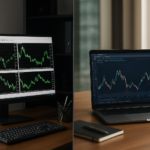Physical Address
304 North Cardinal St.
Dorchester Center, MA 02124

Welcome to the world of robo trading — where algorithms take the wheel and help traders execute strategies with precision, speed, and discipline. If you’re new to this concept or curious about automating your trading, this comprehensive guide will take you through the fundamentals of robo trading, how it works, why it’s becoming so popular, and how you can get started building your own automated strategies using platforms like MetaTrader 5.
Robo trading, also known as algorithmic trading, refers to the use of computer programs that automatically execute trading orders based on a predefined set of rules. These rules can be as simple as a moving average crossover or as complex as a machine learning model that adapts to market behavior. The primary goal is to remove human emotion and error from trading, enabling consistent execution and the ability to trade 24/7.
The process typically includes:
– Designing a trading strategy (technical indicators, chart patterns, or statistical models)
– Programming it into a trading bot using MQL5, Pine Script, or Python
– Backtesting the strategy on historical data
– Optimizing parameters for better performance
– Deploying the bot on a live or demo account
– Monitoring and tweaking over time based on performance
– **Speed**: Bots execute trades in milliseconds
– **Precision**: Orders are placed exactly as programmed, avoiding slippage
– **Emotion-Free**: Bots stick to logic, not fear or greed
– **24/7 Operation**: Especially useful for crypto markets
– **Backtesting Capability**: You can simulate years of data in minutes
– **Overfitting**: Strategies that work in backtests may fail in live trading
– **Technical Complexity**: Requires coding knowledge or access to reliable developers
– **System Failures**: Internet or platform issues can disrupt execution
– **Market Limitations**: Bots may not perform well during unpredictable events or news releases
– **MetaTrader 5**: The industry standard for Forex and CFDs. Uses MQL5 to build EAs (Expert Advisors).
– **TradingView**: Great for designing and testing strategies with Pine Script.
– **cTrader**: Another robust platform for algorithmic trading with its own scripting language (cAlgo).
– **3Commas & Pionex**: Ideal for beginners in crypto bot trading.
– **QuantConnect & MetaStock**: For more advanced and institutional-grade strategies.
– **Trend Following**: Bots that buy when the market is rising and sell when falling.
– **Mean Reversion**: Based on the idea that price returns to its average over time.
– **Breakout Trading**: Enters trades when price breaks key support/resistance levels.
– **Scalping Bots**: Make dozens or hundreds of trades daily for small gains.
– **Martingale/Grid Bots**: Use advanced position sizing; riskier but can be profitable.
– **Entry Rules**: What triggers a trade
– **Exit Rules**: When to close a trade
– **Stop Loss/Take Profit**: Risk management built-in
– **Trade Filters**: Time of day, market volatility, trend indicators
– **Position Sizing**: Determines how much to trade
Before running your bot live, backtesting is essential. This involves running the strategy on historical data to see how it would have performed. Tools like MT5’s strategy tester allow you to:
– Test over multiple years of data
– Optimize strategy parameters (e.g., moving average periods)
– Compare profit/loss, drawdown, win rate, etc.
– Avoid curve fitting by using walk-forward testing or out-of-sample data
Here’s a simple yet powerful strategy:
– Buy when RSI < 30 and price crosses above the 50 EMA
– Sell when RSI > 70 and price crosses below the 50 EMA
– SL = 2% of entry, TP = 4%
– Filters: Only trade during London/New York sessions
This logic can be coded in MQL5 or Pine Script and tested easily in MT5 or TradingView.
– **MetaTrader 5**: For strategy development and testing
– **ForexVPS or Contabo**: Run bots 24/7
– **MyFxBook/FXBlue**: Track bot performance
– **Notion or Excel**: For journaling trades and testing changes
– **MQL5.com/Reddit/Telegram**: Communities for learning, sharing bots, and strategies
– Always test before going live
– Use demo accounts for fine-tuning
– Start with small capital
– Monitor performance weekly
– Keep learning and adapting to market conditions
Robo trading is not just for pros anymore. With platforms like MetaTrader 5, even beginners can start building and testing automated strategies. While it’s not without risk, automation can free you from emotional decisions, speed up execution, and unlock new levels of discipline in your trading. Whether you build your own EA or start with a prebuilt one, the future of trading is automated — and it’s never been more accessible.




